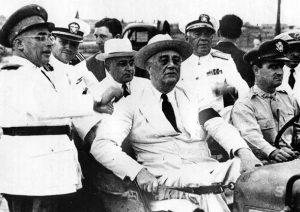|
|
Natal in the World War II
«Back to Home
«Back to Basics
Note: visit this page (in Portuguese) to read about some points of reminiscence of the war which can be visited in Natal today.
Search options of hotels and restaurants in Natal.
The World War II gave an impulse to the growth of Natal and surroundings.
It is estimated that, before the War, Natal had 40,000 inhabitants; after the war, not only the population doubled to nearly 80,000 inhabitants, but the city also had improvements in the infrastructure and one airport (the airport of Parnamirim).
The Americans only entered the War on December 7th 1941, when the Japanese attacked Pearl Harbour; however, since the eclosion of the conflict, in 1939, the Americans were watching with preoccupation the expansion of the Axis powers.
American strategists were concerned with an eventual movement from the Axis towards the American continent; since 1940, Italians and Germans were occupying positions in North Africa; the next step could be the invasion of South America.
In 1939, the Major Delos C. Emmons, commander of the US Air Force, overflew the coast of Brazilian Northeast, and concluded that Natal was the most strategic point, both for a German invasion and for the Allies to use as a supporting site to the operations in Africa.

Franklin D. Roosevelt (in the front seat)
and Getulio Vargas (in the back seat)
visit Parnamirim
The US were not at war yet, and, to not create diplomatic tensions, decided to create a Program for Development of Airfields; to avoid the direct envolvement of the US government, the airline company PanAm was the co-signer of the agreement.
The first airplane to land in Parnamirim was the "Numgesser-et-Coli", a monomotor Breguet-19, piloted by Dieu Coster et Le Brix, on October 14th 1927; before then, only aquaplanes arrived in Natal, on the waters of the Potengi River. According to Clyde Smith Junior, this was itself a Historic flight, because it was the first inter-Atlantic flight in the East-West direction. There was not an airport, however; instead, there was little more than the runway.
With fundings of the US government, the "Parnamirim Field" was constructed. It became the largest US basis outside American territory. Not only the airport, but also the infrastructure (roads, housing, etc) was built from ground.
Thousands of Brazilians migrated to Natal, looking for work. Also, Brazilian soldiers were sent to the Army and Navy bases. These movements explain the growth in population during the period.
After US entered the war, there was no more need for diplomatic actings. On December 11th 1941, a US Navy fleet composed by 9 aircrafts PB4 Catalina and one Clemson arrived in Natal; two weeks later, 50 marines arrived, to patrol the basis.
It is estimated that, during the War, between 3,000 and 5,000 Americans were located in Parnamirim. Also, tens of thousands of Americans and British passed by Natal, in transit. Parnamirim was the busiest airport in the world; flights were taking off and landing every three minutes.
By request of US President Franklin D. Roosevelt, a meeting between him and Brazilian President Getúlio Vargas took place in Natal, on January 27th 1943. The Presidents visited the bases of Air Force, Navy and Army. This meeting consolidated the relations between Brazil and US; in 1944, Brazil sent an Expeditionary troop to fight in Europe.
Because of its importance in the war, the Parnamirim Field was called Trampoline to Victory.
Other links:
Trampoline to Victory.
For All. This is a Brazilian movie which depicts life in Natal during the War times.
Brazil in the World War II.
Natal, em Português.
Back to Top
|
|

